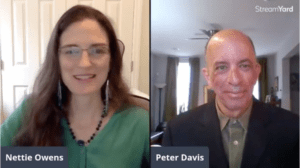How do you focus on people and keep them focused when things are as tumultuous as they are right now?
I think internal communication is key. I think you need to keep everyone updated around what you’re personally thinking as an executive team and around what’s going to be happening. Unfortunately, I’m seeing too many companies doing last-minute communications around decisions related to COVID.
You know what you’re thinking about doing prior to the decision that you actually make. So, as you’re thinking it through, it’s not a bad idea to let your employees know what you’re thinking. Of course, you can let them know that nothing is set in stone – so make that clear as well. But let them know, “This is what I’m thinking, and here’s what’s mulling over in our heads right now.” Human beings really enjoy being prepped for something, and they don’t like it when abrupt things happen.
Then the second thing is just to really lean into that practicality. At the end of the day, no matter what role someone has, this situation may affect their day-to-day roles and responsibilities. Find a way to be a little bit more flexible. I know a lot of companies have leaned into that. But I know a lot of companies still have not.
The last thing, no matter what your personal perspective is around what’s happening, don’t bring any of your own personal or selfish perspectives to the business. We know the politics have been really weird and making people divided, but those things impact the workflow.
I’ve heard companies that are not taking the mass situation as seriously as they could – not closing shop as fast as they probably should based off the rising cases. You really need to contextually unpack each and every employees’ desires. Don’t give fully into what you selfishly think is the right thing. It does not matter. You need to give in to your employees because they’re the ones that are operating your business on a day-to-day basis.
I’ll give my co-founder a little bit of a shout-out. Angela R. Howard is the head of people at a company called Dover. She’s in Chicago, and she’s doing an amazing job. She’s being very aggressive around communications, being very aggressive around leaning into empathy and the conceptual needs of the people there.
So, even when executives may be divided around when we come back, we need to come back, we want to come back – she has been a nice, stable force. She says, “Look, we really need to pay attention to what our people want, what they’re saying and really what the data is saying around this particular situation.” So, she’s done a really good job.
“I think some business owners and founders think, “The more I share, the more concerned my employees are going to be.” Or, they think, “I have to make so many decisions right now. I don’t have time to involve everyone in that.” But maybe this is the time to put those things aside and bring people together. It’s a difficult time to feel cohesive, but the more you can bring your employees into that community, the better off you will be.”
When it comes to driving revenue and creating revenue streams, what out-of-the-box ideas do you have?
I’ll give you a real example first. In New Jersey there was a pizza place – an old school site with the big ovens – and when everything happened, they got shut completely down. But their oven, for some reason – because of the heat could create certain products. I forget the actual something they created, but it was something that the nurses in the global hospitals could utilize.
So, they actually helped out and started creating those things. But the hospitals actually said, “We’ll pay you for these things.” So, it didn’t have to be just a donation. They created a new revenue stream, an actual new business model in the middle of a pizza shop. So, you have to think outside the box.
You can’t look at the scenario and be like, “Well, this is what it is, and I’m just going to die here.” So it just doesn’t work.
Again, at a macro level, you have to think outside the box, like really unpack and understand. What do you have right now within your business model that you can fill up when it’s dead? And how can you try to drive revenue in other ways? How can you get out of your own way and start to lean into the realities of the situation? Whether that’s going direct to the consumer, or through Amazon, or through other mail providers.
Maybe that’s not comfortable for you to learn those things, but this will be something that we’re probably going to have for another year. So be very, very open to looking into all different aspects of revenue streams and business models. Look at competitors out there. And don’t be afraid to burn and break what you normally do; lean into reality. Don’t be so egotistical and comfortable with what you used to do because you won’t survive.
“Have you looked at what you’ve got and pivoted in a way that’s helpful for everyone? What have you learned about yourself and your business by doing this?”
What are some practical ways we can let go of our self-centered decision-making process and do something better?
You can look into the day-to-day realities of your organization. Ask the employees what is best for the organization right now. And here’s what I’m really talking about. Many CEOs, no matter if it’s a small business of 50, 60, or 70 employees or even big organizations – for them, it’s been a while since they’ve been in the day-to-day. And what I mean by that is it’s been a while since they’ve been on the ground floor doing certain things.
So, the processes that you put in place six years ago, when you had a little bit more of an empathetic view and a little bit more of a hands-on experience, may not be the same processes that will be the best for today’s time and your people know about these things.
So, let’s set up a one-on-one or group call and figure out what is working now and what needs to be tweaked or what needs to get adjusted. Be okay with a new perspective, a new workflow, a new decision – and trust that people know the best things that are moving and grooving correctly. They’re probably doing things a little bit different than what you did six weeks or six years prior.
“You may not even have to go back six years. You could just go back 12 months and look at things and say, “Okay, yes, this worked then, but it’s not going to work now, and how can we apply some of that creative thinking here in this situation?”
3 Action Steps
- Communicate with your team so that they are up-to-date on decisions that are being made (or contemplated) and will affect them and the business.
- Investigate out-of-the-box ideas to increase revenue and create additional streams of income for your business.
- Look at the day-to-day operations of your business and ask employees for input on what is working and what isn’t.
Connect with Anthony Vaughan at LinkedIn.
Please comment below. I would love to hear from you.














No comments yet.